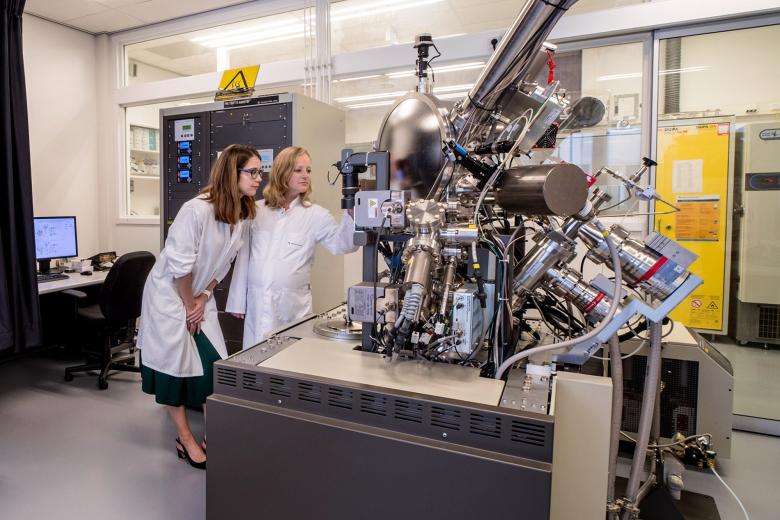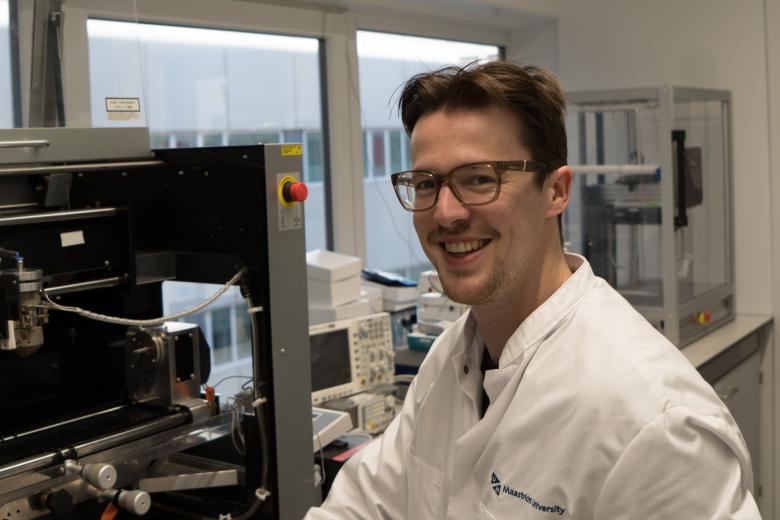Understanding the beginning: how does an embryo really implant?
Dr. Ron van Golde is a gynaecologist and specialist in reproductive medicine at MUMC+. He has recently become the chair of the Department of Obstetrics and Gynaecology. His work focuses on people in whom pregnancy fails. Van Golde is affiliated with the GROW research institute at the Faculty of Health, Medicine, and Life Sciences of Maastricht University. Together with researchers from GROW and MERLN, he works to improve IVF care. Specifically, he aims to better understand how embryos implant in the uterine wall. Van Golde: “Our focus is on ‘the bed’.”
Fertility and embryo selection
Van Golde has long been interested in research in the field of fertility and embryo selection. Van Golde: “I come from Maastricht and studied medicine here. At that time, embryo selection techniques were just starting up. But even in secondary school - thanks to an enthusiastic biology teacher - I had a passion for genetics. And not only did I find genetics interesting; I was also fascinated by how a cluster of cells becomes a human”.
In Vitro Fertilization (IVF) in Maastricht
“Within our department, one of the things we focus on is people who would like to get pregnant but who are unable to do so. We look for reasons why they are unsuccessful. A number of factors are known for infertility: no eggs mature, no ovulation occurs, the fallopian tubes are closed or the sperm is not of good quality. We try to help those people become pregnant in a healthy way. This is most often done through In Vitro Fertilization (IVF). IVF is a fertility treatment in which eggs are fertilized with sperm cells outside the woman’s body. After fertilization, the embryo is placed in the uterus. Maastricht is the only IVF center in Limburg. Every year we see about 1,000 patients here, 300 of whom undergo IVF treatment. The remaining patients become pregnant naturally.
Besides IVF for fertility problems, we also use this technique for embryo selection. This involves genetic testing to prevent certain diseases from being passed from parents to their children. In this treatment, a genetic test called PGT (preimplantation genetic testing) is done, after which only healthy embryos are placed back into the uterus. MUMC+ is the only licensed centre in the Netherlands that can perform this genetic diagnostics. IVF centres in Utrecht, Amsterdam, Groningen, and Maastricht perform IVF treatment combined with this PGT. In Maastricht, this happens about 300 times per year. We perform just as many treatments for infertility as for embryo selection, with the latter growing in recent years”.
Black box
“With researchers from the GROW and MERLN Institutes, we are working together to improve IVF care. To answer the question of why getting pregnant fails, we are now doing research on the implantation process of embryos. Look: in IVF treatment, we can very well grow an egg and remove it from the body. But what happens next is a black box for us. When an embryo is placed back into the uterus, you hope it will implant. But exactly how that happens, step by step, we don't know. What we do know is that it is a big waste race. Only one third of the embryos implant”.
I believe that from Maastricht, we can really make a difference in this collaboration for both patients and science.
Endometrium on a chip
“Here in Maastricht, we have opened a clinic for people in whom embryos have been transferred more often but who did not get pregnant. We call that repeated implantation failure. In this clinic we are conducting scientific research. In patients - who come from all over the country - we take endometrium samples. With this, one of the researchers, Erik Vrij, makes organoids, also called ‘endometrium on a chip’. We combine this with MERLN's technique to create artificial embryos. These embryos are not made from an egg and sperm cell, but from stem cells. The embryos are then flowed over the endometrium as a fluid flow. In both people who got pregnant easily and those who have to try again and again, we look at how many, and which embryos, will ‘stick’. With this, we hope to see what exactly is that first step in the process of implantation. Our focus is on the bed; see that the embryo is implanted properly”.
Testing the model
“We also look deeper into the endometrial tissue to better understand what it is made of. What cells are in it? And what function do they have during implantation? With what we learn, we aim to develop personalized treatments to give IVF patients a better chance of success. We have now taken endometrium samples from about 80 patients. We run tests on that. The advantage of such an endometrial model is that you can study the effect of adding hormones, for example. In this way we hope to discover which patient has which problem. Is something going wrong in the hormonal control, in the microbiome of the vagina or with the immune cells? We were surprised to find how well the model works. That if you give the right hormones many more embryos stay attached. It’s a very simple model but it does it well.
I sought collaboration with MERLN when I realized that they work with artificial embryos while we have an IVF laboratory where we create live embryos. There is no doubt that we can learn a lot from each other. And that’s exactly what’s happening. There are beautiful connections in the collaboration between GROW and MERLN. On the GROW side, a lot of research has been done on the local regulation of hormones, knowledge that we can now use again when administering hormones to models. Knowledge from GROW also reaches MERLN, for example, about how the endometrium functions when it grows and what changes occur to allow embryo implantation. This knowledge can then be applied to the model”.
A successful group
“In our study, researchers with different perspectives are represented. In weekly meetings, each one shares their insights from their field. Meanwhile, we form a group of about 25 people, including PhD students. We call ourselves: human reproductive success. It's a bit premature, but you have to dream, right? Our group feels like a kind of growth diamond in that we have all these senior researchers working on the same theme of ‘how do people get pregnant easier’ from different perspectives. I think with that diversity, we’ve laid a good foundation to keep competing in the top tier in the future. It's a great example of connecting. To me, connecting only works if you really have a clear goal together. We have that here and it shows: together you really do get further. I think that in this collaboration we can really make a difference for patients and science”.
In an academic environment, you should keep questioning the world like a 4-year-old.
Problem-Based Learning (PBL)
“You can see the influence of problem-based learning (PBL) in the entire group. There’s a lot of curiosity, reflected in the constant asking of 'why?' There's so much we don't know. When you ask one question, you get thirty back. I also notice that this curiosity, the desire to share knowledge, gives depth and enthusiasm, especially to younger researchers. I think this curiosity is crucial. In an academic environment, you should keep questioning the world as a 4-year-old would. The PBL system encourages curious learning”.
Application and impact
“With our research, we want to find out why it is that only one-third of returned embryos implant. With the knowledge we gain, we hope to be able to improve the implantation rate. Right now, the chance of getting pregnant is about 30% per attempt. People get three attempts covered, and in total, they have about a 60-70% chance of becoming pregnant. If we can increase the chances per attempt to 35-40%, and the overall success rate to 70-80%, it would be a huge improvement.
In our society, we have come to think it is normal for people to go through heavy hormonal treatment and then have to undergo a puncture to get pregnant, but it is not. And on top of these technical aspects, we also see here how much impact ‘not getting pregnant’ has on patients emotionally. So more successful implantations will bring a lot. There’s also the societal importance, if you look at the cost aspect. IVF treatments are expensive. So for that reason too, it is desirable to get more success out of the attempts. My dream is to increase the success rate of pregnancies by 5-10%. This should be possible if we can develop a number of tests based on our research. Then we will be able to determine the reason for each patient's failure early in the process and offer a treatment specific to their situation”.
Future research
“As an extension of the research into the implantation of the embryo, I also see applications in other disorders of the endometrium such as menstrual complaints, irregular blood loss, endometriosis (in which mucous membrane extends outside the uterus) and cancer. Now that we have the models at our disposal, we can also study how cervical cancer develops. You can then take tissue from someone and add substances in the laboratory to see if you can improve the oncological prognosis.
I hope that we find 2 or 3 things that give reason to improve the success rates. That we really start to understand the process: how does implantation happen? How fast do the cells go down? Do they then kind of interact with the immune cells? How far do they need to grow? How do blood vessels form? I think we are in for some exciting surprises!”
Text: Eline Dekker
Photo: Joey Roberts
Also read
-
UM to play a more prominent role in Dutch scientific infrastructure
Eleven consortia from various scientific disciplines are set to launch projects of great value to science. The Dutch government is making a total of €197 million available for this purpose. Scientists from Maastricht University (UM) are closely involved in seven of the eleven projects.

-
17 million for Dutch mega cohort: working together to build healthier ageing
MUMC+ is main applicant in the NCC: a unique research infrastructure with data from almost half a million Dutch citizens.
-
Letting bone and cartilage repair themselves
Tim ten Brink focuses on developing implants for damaged bone and cartilage, so eventually there is less need for invasive surgery.
